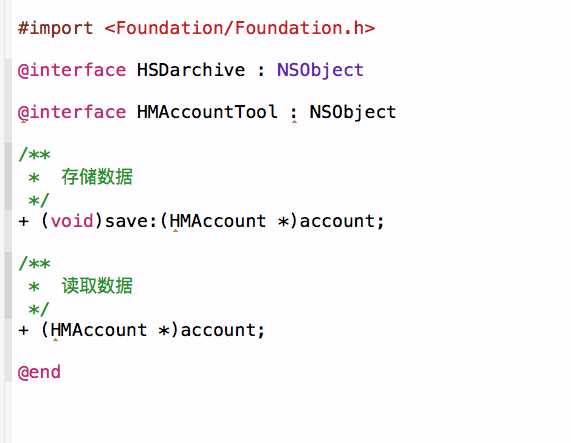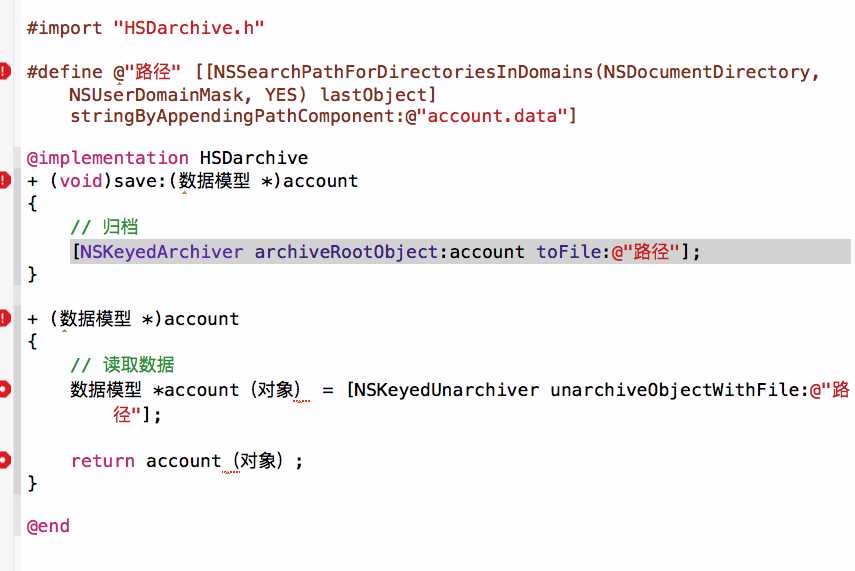标签:
1.把要显示的数据转换为模型,把对象归档,然后把存起来的对象解析出来就可以使用
2.可以封装起来方便使用,封装的方法存入百度云,需要的可以留言
/** 归档方法 */
-(void)archive
{
/**
* 常用的几个文件目录 directory目录
* NSDownloadsDirectory 下载文件目录
* NSDocumentDirectory 数据文件目录
* NSCachesDirectory 缓存文件目录
* NSMoviesDirectory 电影文件目录
* NSPicturesDirectory 图片文件目录
* NSMusicDirectory 音乐文件目录
*
*/
NSArray *myPaths = NSSearchPathForDirectoriesInDomains(NSDocumentDirectory, NSUserDomainMask, YES);
//Document目录下的第一个文件对象
NSString *docPath = [myPaths firstObject];
//新建一个文件并返回该文件路径
NSString *fileNamePath = [docPath stringByAppendingPathComponent:@"archive.data"];
//归档
[NSKeyedArchiver archiveRootObject:@"数据模型" toFile:fileNamePath];
//读档
NSString *duixaing = [NSKeyedUnarchiver unarchiveObjectWithFile:fileNamePath];
}
存档的另一种方法,自己需要研究的是归档的路径,归档的方法 ,读档的方法(注明用的是两个不同的类,一个是存档的类,一个是读档的类,)
存的数据是以二进制的形式存进手机本地的
/** 保存数据进行归档 */
- (IBAction)saveBtn:(id)sender {
NSString *filePath = [self filePathWithfileName:@"student.archive"];
NSMutableData *theData = [NSMutableData data];
NSKeyedArchiver *archiver = [[NSKeyedArchiver alloc] initForWritingWithMutableData:theData];
studentsInfo *Info = [[studentsInfo alloc] init];
Info.sno = self.snoLabel.text;
Info.name = self.nameLabel.text;
Info.classes = self.classLabel.text;
[archiver encodeObject:Info forKey:@"mystudent"];
[archiver finishEncoding];
[theData writeToFile:filePath atomically:YES];
NSLog(@"%@",filePath);
}
/** 归档文件读取数据 */
- (IBAction)readBtn:(id)sender {
NSString *filePath = [self filePathWithfileName:@"student.archive"];
NSData *data = [NSData dataWithContentsOfFile:filePath];
if (data.length > 0) {
NSKeyedUnarchiver *Unarchiver = [[NSKeyedUnarchiver alloc] initForReadingWithData:data];
studentsInfo *Info = [Unarchiver decodeObjectForKey:@"mystudent"];
[Unarchiver finishDecoding];
self.snoLabel.text = Info.sno;
self.nameLabel.text = Info.name;
self.classLabel.text = Info.classes;
}
}
/** 返回一个在document文件下的文件的路径(自己创建的文件) */
-(NSString *)filePathWithfileName:(NSString *)fileName
{
NSArray *myPaths = NSSearchPathForDirectoriesInDomains(NSDocumentDirectory, NSUserDomainMask, YES);
NSString *myDocPath = [myPaths firstObject];
NSString *filename = [myDocPath stringByAppendingPathComponent:fileName];
return filename;
}
如图示封装的伪代码,使用方法引用头儿文件既可。


标签:
原文地址:http://www.cnblogs.com/ZHP-Study-share/p/5419202.html